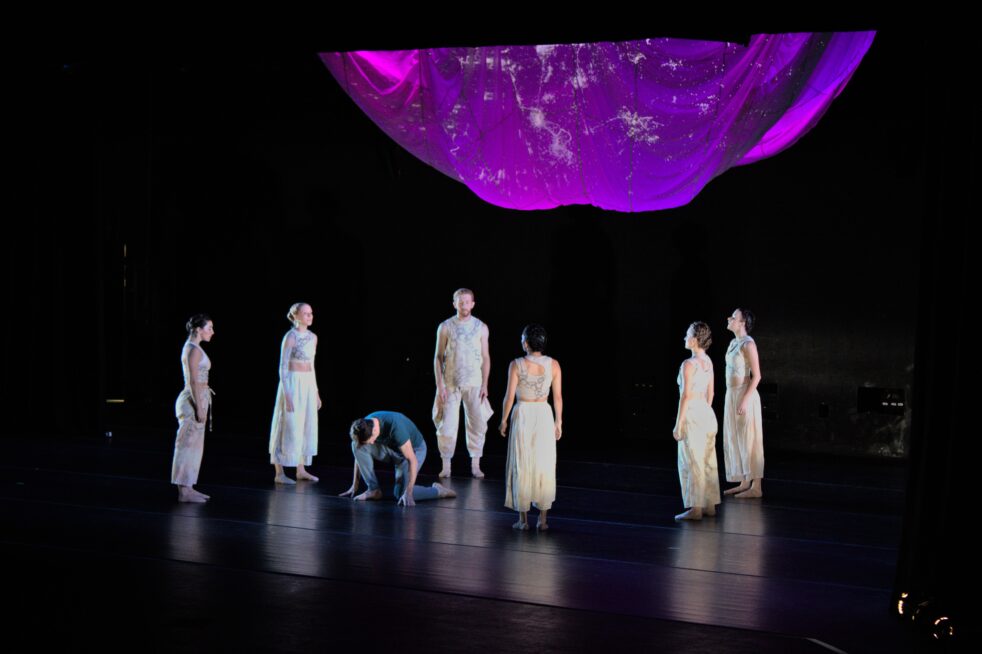On Sunday Sept. 11, the curtain of the Ferst Center rose on the opening movement of “Step the Brain Along a Path” to reveal a single dancer, spotlighted and dressed in blue, standing on the right side of the stage. On the left clustered a neutrally-clad ensemble, meant to symbolize her brain cells. When they initiate a movement, a projection on the scrim in front of them shoots across the stage to the woman on the right, and she responds with almost-jerky, externalized movements of her own. Later, the audience will learn that the dancer’s name is Rachel, and that she is one of four humans in the ballet who are experimenting with brain-machine interfaces to achieve a goal — for Rachel, perfect physical control.
“Step the Brain Along a Path,” a multimedia performance created in collaboration with Georgia Tech Arts, is the brainchild of Christopher Rozell, a professor and researcher in the School of Electrical and Computer Engineering, and Aaron Shackelford, director of Georgia Tech Arts. Rozell’s pathway to neuroscience began with studying music in college, and he approached Shackelford after hearing the latter’s vision for how arts and sciences could be integrated at Tech.
“When Aaron came back to me and told me we were going to use dance for the project, I thought he was insane,” Rozell said. “I didn’t know much about the discipline, but I thought that it lacked the narrative expression that we needed.”
Enter Troy Schumacher, a dancer, director and choreographer whose work has been presented by New York City Ballet, the Martha Graham Dance Company, the Joyce Theater and many others. Schumacher had always wanted to work with scientists, and when Shackelford approached him with the idea of a ballet about neuroethics, he could not turn it down.
“This area of neuroscience and AI is one of the most important things happening to humanity,” Schumacher said. “It’s going to change the world. And we wanted to give people a way to take a second to think about it. There are so many ways to make it dark and scary the entire time, but there’s also a lot of hope and beauty to it. Scientists are doing this to accomplish things that nothing else can.”
Rozell’s initial skepticism of a dance-based project was short-lived.
“I could see the genius that Troy brings to the table and I fell in love with the power of integrating the arts into what we’re doing. Engineering and dance are both fundamentally creative disciplines; they’re both about designing something under constraints that force you to be even more creative,” Rozell said.
With great technology comes great responsibility, and the work that Rozell does on technologies that interface with the brain is no exception. Ethical questions on the matter abound: When is one allowed to artificially change someone’s mood? Should these technologies be used to cure mental illness? To improve performance? To perfect memory? Who regulates this kind of technology? Should it be used on a child? These are the questions that “Step the Brain Along a Path” takes on.
“The technology that brings them to light is so new that the language around it is still emerging,” Rozell said. “We’re right at the edge of what we know. Art is uniquely capable of giving us a way to communicate and reason about concepts that we don’t have a language for yet, and as I learned more about dance, I realized that it made perfect sense to use a movement-based discipline. Movement is fundamentally tied to how humans interact with the world around them.”
To bring the project to life, Shackelford tapped Terminus Modern Ballet Theatre, an Atlanta-based dance company with a vision of pushing the limits of classical ballet.
Terminus is small but mighty and well-suited to the task of translating complex scientific challenges into an accessible work of art.
“Step the Brain Along a Path” opens with a loose narrative of four humans interacting with brain-human interfaces, each with a different goal: controlling their physicality, time, emotions or memory.
After setting up its initial premise, it quickly meanders into other, even more abstract possibilities — the potential risks and benefits of such control as well as the implications for memory and loss.
Set to a hypnotic score by Alex Somers and presented in conjunction with the brilliant work of projection artist Sergio Mora-Diaz, the work is an immersive deep dive inside the brain that needs to be experienced as much as it is understood.
The Terminus dancers offer a classical grounding and a contemporary intrepidity that makes them mesmerizing as Schumacher’s work takes them in and out of classical forms.
“You need multiple disciplines to fully understand the brain,” said Karen Rommelfanger, the president and founder of the Institute of Neuroethics Think and Do Tank, at a post-performance panel on Sunday. “The future of neurotechnology is as unimaginable today as for the smartphone was when it first came out, but dance allows us a vocabulary to imagine it.”
